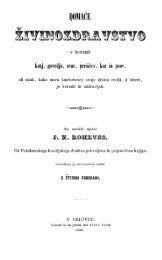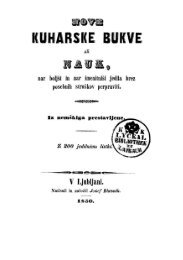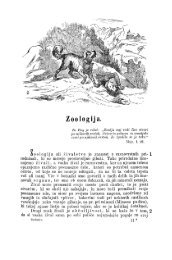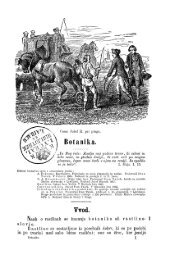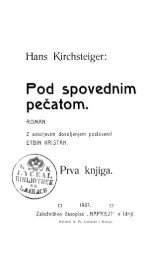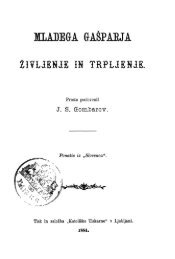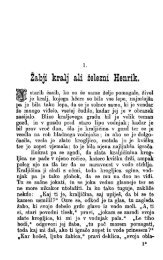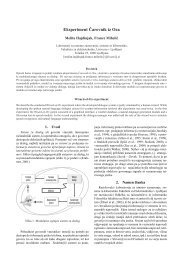Proceedings - Natural Language Server - IJS
Proceedings - Natural Language Server - IJS
Proceedings - Natural Language Server - IJS
You also want an ePaper? Increase the reach of your titles
YUMPU automatically turns print PDFs into web optimized ePapers that Google loves.
CycL of the underlying translated sentence. It is incomplete<br />
because terms like :SUBJECT still need to<br />
be instantiated. We implemented the following subcategorization<br />
frames:<br />
• Transitive noun phrase frame (subject, verb,<br />
object), e.g., “John drives a car.”<br />
• Intrasitive verb frame (subject, verb), e.g., “John<br />
swims.”<br />
• Ditransitive prepositional phrase frame (subject,<br />
verb, object, preposition, oblique-object), e.g.,<br />
“John passed the ball to Tom.”<br />
• Copula frame (subject, complement), e.g., “John<br />
is sad.”<br />
2. Rule for semantically poorer verbSemTrans relations.<br />
Frame and verb combinations that are not covered<br />
by the first rule, may be covered by this rule.<br />
This rule also uses verbSemTrans relations. But these<br />
are not stored in Cyc, instead, they are automatically<br />
generated. This is an example of such relation:<br />
(#$verbSemTrans #$Drive-TheWord 1<br />
#$TransitiveNPFrame<br />
(#$and<br />
(#$isa :ACTION<br />
TransportInvolvingADriver)<br />
(#$actor :ACTION :OBJECT)<br />
(#$actor :ACTION :SUBJECT)<br />
))<br />
This relation is similar, but the CycL in the last argument<br />
is semantically poorer, than the one on Listing 2.<br />
This is because predicate actors means just that the<br />
last argument of the relation is somehow involved in<br />
the action.<br />
3. Oblique-object rule. This rule is executed only if ditransitive<br />
prepositional phrase frame rule was applied<br />
before. It is used to correctly extract oblique objects<br />
from the prepositional phrase.<br />
4. Free variable rule. This rule is executed on interrogative<br />
pronouns, e.g., who, what, in the interrogative<br />
sentences, which are recognized by CLAUSE-TYPE<br />
- INT attribute-value pair in the f-structure. Interrogative<br />
pronouns are recognized by PRON-TYPE -<br />
INT pair and are translated into CycL variables. Consequently,<br />
the final construct of the translation is not a<br />
CycL sentence, but a CycL query.<br />
5. Cyc denotation rule. This rule finds a Cyc concept for<br />
a part of the sentence (see Subsection 3.3.)<br />
6. Enrycher annotation rule. Details of resolving the<br />
annotation are presented in Subsection 3.2.. Names<br />
and types of entities are connected by this<br />
rule. Here is an example of the result of the rule:<br />
(#$thereExists ?OBJECT<br />
(#$and<br />
(#$isa ?OBJECT #$Person)<br />
(#$nameString ?OBJECT<br />
"Tiger Woods")<br />
)).<br />
7. Noun phrase splitting rule. This rule splits the noun<br />
phrase into the main noun and the possible modifiers.<br />
Each modifier is connected to the main noun<br />
with the predicate featureOf, which is semantically<br />
very poor. For example, “white rabbit” is translated<br />
into (#$featureOf #$Rabbit #$WhiteColor).<br />
Example of the semantically richer relation would be,<br />
(#$mainColorOf #$Rabbit #$WhiteColor).<br />
8. String instance rule. This is the last rule. It always<br />
succeeds. It is applied on a part or even<br />
whole sentences. It uses Cyc function InstanceFn.<br />
The result of the function is a Cyc concept,<br />
which is named after the functions only argument.<br />
Here is an example of the result of the rule:<br />
(#$InstanceFn "quasicrystal")<br />
3.5. Asserting sentences to Cyc KB<br />
The result of the translation is one or, due to homonomy,<br />
multiple CycL sentences. For each natural language<br />
sentence, we create a microtheory, for example,<br />
(#$MtWithFocalContentSentenceFn "Francisco<br />
Liriano will start for the Twins.")<br />
We did not use a single microtheory for all senteces, because<br />
contradictions may appear due to news writing bias.<br />
We try to assert all possible translations of a particular sentence<br />
into its microtheory one by one. If a particular translated<br />
sentence is contradictory, it is rejected.<br />
3.6. Question answering<br />
The question answering feature was also added to our<br />
system. It is possible to make a natural language question.<br />
This question is translated to the CycL query. Cyc will answer<br />
the query by providing all the answers to it. If we asserted<br />
the translation of the sentence: Clint Eastwood eats<br />
a steak. We can ask a question like: What does the actor<br />
eat? This is the query translated from the sentence:<br />
(#$thereExists ?SUBJECT<br />
(#$and<br />
(#$isa ?SUBJECT #$Actor)<br />
(#$thereExists ?ACTION<br />
(#$and<br />
(#$isa ?ACTION #$EatingEvent)<br />
(#$performedBy ?ACTION ?SUBJECT)<br />
(#$consumedObject ?ACTION ?OBJECT)<br />
))))<br />
The answer to the query, in which ?OBJECT is the variable,<br />
is (SKF-1534975054). This concept is a Skolem term<br />
that represents the particular steak that Clint Eastwood eats.<br />
4. Evaluation<br />
In this section, we will first present the empirical evaluation,<br />
and then an experiment that we conducted on our<br />
system. Since the start of this project, we have taken into<br />
account that translating text to knowledge representation is<br />
a hard problem, if not impossible. A system like ours would<br />
need a huge number of rules to get a good coverage. Since<br />
the basic unit of our input is a sentence, we filtered out<br />
sentences that are not going to produce good translations<br />
182




